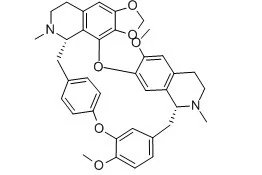What is Cepharanthine?
Overview: Cepharanthine, a leukoproliferative drug, promotes the proliferation of bone marrow tissue, thereby elevating white blood cells. It is used for leukopenia. It can increase peripheral blood leukocytes, and animal experiments have found that it can significantly prevent mitomycin-induced leukopenia, but does not inhibit the anticancer effect of mitomycin. Its mechanism of action is to promote the proliferation of bone marrow tissue, thus producing an elevated leukocyte effect. It is used for granulocyte deficiency and other causes of leukopenia due to chemotherapy and radiotherapy of tumors.
Originally used in traditional Chinese medicine, it was reported by botanist Bunzo Hayata in 1914 and was purified and named Stephania japonica twenty years later by Professor Heisaburo Kondo, a pharmacologist at the University of Tokyo.
On May 10, 2022, a new drug for the treatment of COVID-19 discovered by Chinese scientists was granted a national invention patent. The patent specification showed that 10 μM (micromol/liter) of Cepharanthine inhibited coronavirus replication by a factor of 15,393. American scholars have also since published a paper in Science confirming that the data for milliputinin shines among the 26 drugs it studied and is superior to raltegravir and paroviride, which are already approved for marketing.

English Name: Cepharanthine
Alias: Cepharanthin
Chemical Formula: C37H38N2O6
Molecular Weight:606.71
CAS. Number: 481-49-2
Appearance: White Crystal Powder
Extraction Source: Stephania japonica( Thunb. ) Miers, Stephania epigaea Lo
Melting Point:145-147°
Storage: 2-8°C, protected from light, stored at low temperature.
Acute toxicity: oral-rat LD50: 2000 mg/kg; oral-mouse LD50: 1900 mg/kg